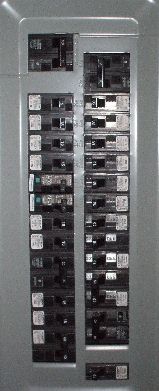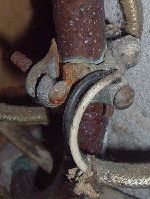|

Breaker panel
|
|
|

Fuse panel
|
| ... |
|

15 and 20 amp fuse rejecters
|
If the house is equipped with a fuse panel, it is recommended to install washers. Washers come in different sizes and prevent a fuse of higher rating from making contact.
If you replace a fuse do not over tighten it, you may bend the bus bar behind the fuse and cause bad connections to other fuses which could lead to overheating and fires. |
|
|
..
.
|

15 amp fuse with double tap
|
| Double Taps and/or an assortment of small sub-panels are signs of a 'full' panel. Upgrading to a 32 circuit breaker panel is strongly recommended especially if additional circuits are required for finishing the basement or upgrading the kitchen. |
|
| ... |

Ground clamp
|
Ground Clamp. To ensure good contact and grounding you should:
- Fasten loose ground clamp and/or ground wire.
- Replace a corroded ground clamp.
- Replace a badly nicked or broken ground wire (no splicing allowed). |
|
Electrical - Supply
Service Size, Main Disconnect and Distribution Panel.
Fuses Breakers and Grounding |
|
| . |
Need more information? Use our search box
Service Size. Main Disconnect. Main Distribution Panel
The size of the service depends on the power supply which is measured in amps. Common services for residential dwellings are 100, 125, 150, 200 amps and for older homes, 60 amps.
Service size cannot be determined by:
- Adding the fuse or breaker ratings in the main distribution panel.
- Taking the rating from the distribution panel cover.
- Taking the rating from the hydro meter.
- The size of the overhead wires.
|
|
Service size is determined by:
- Service entrance cable (SEC) size.
- The rating of the cartridge fuse or main breaker.
Upgrading. many older homes still have a 60 amp service which is no longer considered to be adequate for today's needs. Upgrading to 100 amp is recommended. |
MAIN DISCONNECT
The main disconnect is a switch (fuse panels) or a breaker (breaker panels). It is an over-current device that is located in a separate service box or is part of the main distribution panel in which case it has its own cover. Hydro seals are installed for safety and should not be broken.
MAIN DISTRIBUTION PANEL
This panel controls the distribution of power throughout the house. The panel is often referred to as the fuse panel or breaker panel, depending on the circuit protection. The panel is usually located in the basement and sometimes in the garage. In rare cases it is located on the exterior of the house in some kind of enclosure.
| Warning. There are always live wires inside the distribution panel box, even if the switch or main breaker is shut off. |
|
| .... |
Grounding. Fuses. Breakers
Grounding is a safety feature of the electrical system. A short circuit can pass electricity through metal parts that are not supposed to be energized. A ground wire carries the 'leaked' electricity safely to the ground.
The ground wire is fastened with a ground clamp to the water main (below the water meter) or two ground rods which are 10 ft. (3 m) log rods driven into the ground.
Jumper cable. If the system is grounded above the water meter, a jumper cable is required that by-passes the water meter and shutoff valve.
|
|
FUSES AND BREAKERS
Fuses and breakers are over-current devices. Fuse blocks control the 240-volt circuits and contain two cartridge fuses. A fuse is equipped with a strip of metal made of a low melting point alloy. it will melt when current exceeds a predetermined amount. Installing a higher rated fuse to replace a blown one is dangerous and could result in a fire...
Many of the older fuse panels have been replaced by breaker panels.
|
| WARNING. Use only 15 amp fuses for circuits supplying lights and receptacles. |
How to 'read' a blown fuse. Blown fuses or tripping breakers are signs of problems. A blackened fuse indicates a short circuit. Usually this will be an appliance. A blown fuse that is not blackened indicates an overloaded circuit. If the problem persists, call an electrician.
How to find a short circuit. (this should be done by a certified electrician)
1- Remove the blackened fuse.
2- Replace it with a 40 watt light bulb, if it lights up, there is a short circuit.
3- Unplug all the appliances and turn off all the lights on that circuit one at the time, checking the light bulb each time.
4- The light bulb will go out when the defective cord, light or appliance is removed.
|
| ... |
|
|
| ... |
| Back to Top |
|
|